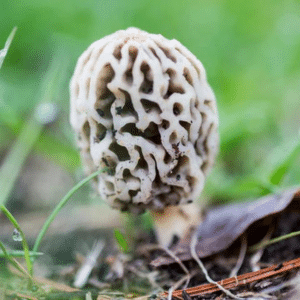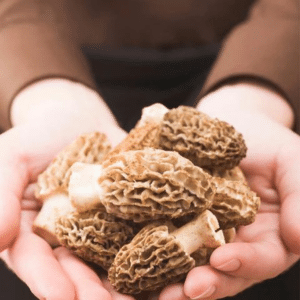
SHIITAKE: Grow Kit Instructions
Learn how to grow Shiitake mushrooms using the Myterra Labs
RECEIVE 10% OFF ON YOUR FIRST ORDER! – USE CODE: WELCOME10
Morel mushrooms are one of the most prized and sought-after edible mushrooms in the world. These delicious fungi are known for their unique shape, honeycomb-like appearance, and rich flavor. Morels are a seasonal delicacy that can be foraged in the wild, and they are particularly popular among foodies, gourmet chefs, and mushroom hunters.
If you are a fan of mushrooms or are curious about foraging, you may be interested in learning more about morels, when they can be foraged, and where to look for them. In this blog post, we will delve into the world of morels and explore everything you need to know to find these delectable mushrooms in the wild.
Morels are a type of edible mushroom that belong to the genus Morchella. These fungi are known for their distinctive appearance, which features a cap that resembles a honeycomb or sponge-like texture. Morels can range in color from light tan to dark brown, and they are typically found growing in wooded areas, particularly near dead or dying trees.
Morels are a seasonal mushroom, and their growth and appearance are dependent on a variety of environmental factors, including temperature, moisture, and sunlight. Morels are typically found in the spring, although the exact timing of their emergence can vary depending on the region and climate.

As previously mentioned, morels are a seasonal mushroom that typically emerges in the spring. However, the exact timing of their emergence can vary depending on a variety of factors, including geographic location, weather conditions, and elevation.
In general, morels tend to emerge when the temperature reaches a consistent 50-60°F, and the soil temperature is above 40°F. These conditions typically occur in early to mid-spring, although the exact timing can vary by region.
If you are interested in foraging for morels, it is important to keep an eye on the weather and temperature in your area. You can also look for signs of morel growth, such as the emergence of other spring wildflowers or the appearance of certain tree buds. Once you have a sense of when morels are likely to appear in your area, you can start planning your foraging trip.

Morels are typically found growing in wooded areas, particularly near dead or dying trees. However, there are a few key factors to consider when looking for morels in the wild.
1. Soil type
Morels tend to grow in moist, well-drained soils that are rich in organic matter. Look for areas with loose, loamy soil, and avoid areas with heavy clay or sandy soils.
2. Tree species
Morels are often found near certain tree species, including ash, elm, oak, and apple trees. Look for areas with a high concentration of these trees, and pay close attention to any dead or dying trees.
3. Elevation
Morels tend to grow at higher elevations, particularly in areas with cool, moist climates. Look for areas with a high elevation, such as hillsides or mountain slopes.
4. Microclimate
Morels are sensitive to environmental factors such as temperature and moisture. Look for areas with a microclimate that is conducive to morel growth, such as areas near bodies of water or in areas that receive dappled sunlight.
5. Previous years’ sightings
Morels tend to grow in the same area year after year, so if you have had success in a particular area in the past, it is likely that you will find morels there again. Keep a record of your foraging trips and take note of any areas where you have found morels in the past.

Foraging for morel mushrooms can be a fun and rewarding experience for those who love mushrooms and the great outdoors. By following the tips outlined in this blog post, you can increase your chances of finding morels in the wild and enjoy their delicious flavor in a variety of dishes. Remember to always be careful and responsible when foraging, and respect the environment and wildlife around you. Happy hunting!

Morel mushrooms are one of the most prized and sought-after edible mushrooms in the world. These delicious fungi are known for their unique shape, honeycomb-like appearance, and rich flavor. Morels are a seasonal delicacy that can be foraged in the wild, and they are particularly popular among foodies, gourmet chefs, and mushroom hunters.
If you are a fan of mushrooms or are curious about foraging, you may be interested in learning more about morels, when they can be foraged, and where to look for them. In this blog post, we will delve into the world of morels and explore everything you need to know to find these delectable mushrooms in the wild.
Morels are a type of edible mushroom that belong to the genus Morchella. These fungi are known for their distinctive appearance, which features a cap that resembles a honeycomb or sponge-like texture. Morels can range in color from light tan to dark brown, and they are typically found growing in wooded areas, particularly near dead or dying trees.
Morels are a seasonal mushroom, and their growth and appearance are dependent on a variety of environmental factors, including temperature, moisture, and sunlight. Morels are typically found in the spring, although the exact timing of their emergence can vary depending on the region and climate.

As previously mentioned, morels are a seasonal mushroom that typically emerges in the spring. However, the exact timing of their emergence can vary depending on a variety of factors, including geographic location, weather conditions, and elevation.
In general, morels tend to emerge when the temperature reaches a consistent 50-60°F, and the soil temperature is above 40°F. These conditions typically occur in early to mid-spring, although the exact timing can vary by region.
If you are interested in foraging for morels, it is important to keep an eye on the weather and temperature in your area. You can also look for signs of morel growth, such as the emergence of other spring wildflowers or the appearance of certain tree buds. Once you have a sense of when morels are likely to appear in your area, you can start planning your foraging trip.

Morels are typically found growing in wooded areas, particularly near dead or dying trees. However, there are a few key factors to consider when looking for morels in the wild.
1. Soil type
Morels tend to grow in moist, well-drained soils that are rich in organic matter. Look for areas with loose, loamy soil, and avoid areas with heavy clay or sandy soils.
2. Tree species
Morels are often found near certain tree species, including ash, elm, oak, and apple trees. Look for areas with a high concentration of these trees, and pay close attention to any dead or dying trees.
3. Elevation
Morels tend to grow at higher elevations, particularly in areas with cool, moist climates. Look for areas with a high elevation, such as hillsides or mountain slopes.
4. Microclimate
Morels are sensitive to environmental factors such as temperature and moisture. Look for areas with a microclimate that is conducive to morel growth, such as areas near bodies of water or in areas that receive dappled sunlight.
5. Previous years’ sightings
Morels tend to grow in the same area year after year, so if you have had success in a particular area in the past, it is likely that you will find morels there again. Keep a record of your foraging trips and take note of any areas where you have found morels in the past.

Foraging for morel mushrooms can be a fun and rewarding experience for those who love mushrooms and the great outdoors. By following the tips outlined in this blog post, you can increase your chances of finding morels in the wild and enjoy their delicious flavor in a variety of dishes. Remember to always be careful and responsible when foraging, and respect the environment and wildlife around you. Happy hunting!


Learn how to grow Shiitake mushrooms using the Myterra Labs

Selecting the right substrate is a key element in successful

Welcome to the enchanting realm of our All-in-one Grow Kit,
© 2023 Myterra Labs. Designed by Laura Ramsay. Developed by Info2grow Media Services.